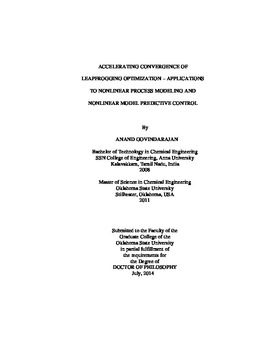| dc.contributor.advisor | Rhinehart, R. Russell | |
| dc.contributor.author | Govindarajan, Anand | |
| dc.date.accessioned | 2015-06-17T20:06:02Z | |
| dc.date.available | 2015-06-17T20:06:02Z | |
| dc.date.issued | 2014-07 | |
| dc.identifier.uri | https://hdl.handle.net/11244/14855 | |
| dc.description.abstract | Conventionally used optimization methods in chemical engineering applications such as linear programming (LP), Levenberg-Marquardt and sequential quadratic programming (SQP) handle nonlinear objective function (OF) surfaces by linearizing or assuming quadratic behavior of the surfaces [1]. Process modeling and nonlinear model predictive control (NMPC) applications, however, present OF surfaces with surface aberrations such as steep slopes, discontinuities, and hard constraints which require a robust and efficient optimization method. Therefore, an optimization method that can handle surface aberrations is required. | |
| dc.description.abstract | Leapfrogging (LF) is a recently developed direct search optimization method, potentially best-in-class, which can handle surface aberrations. LF starts with a set of players (trial solutions), randomly placed in the decision variable (DV) space. The worst player (player with the worst OF value) leaps over the best player into a reflected hypervolume [2]. The leapovers continue until all the players converge. LF is robust and efficient - with minimal computation effort (compared to conventional optimization methods), it can handle the challenges posed by nonlinear OF surfaces. LF was demonstrated on over 40 test functions and several modeling and NMPC applications. Rigorous fundamental analysis of LF is required - for a finer understanding of the method, exploring opportunities for improvement and scaling LF applications to large scale systems. | |
| dc.description.abstract | This work is focused on exploring and analyzing methods to accelerate convergence of LF, demonstrating application credibility on nonlinear process modeling of steady state binary distillation and NMPC of a binary distillation column. Accelerating convergence opens the doors for using LF in large scale problems that have several hundred variables such as real time optimization and refinery planning where computational effort and time are of essence. Distillation modeling is constrained, nonlinear, and has optimum confined to a narrow region; distillation control is multivariable, interacting, nonlinear and has severe disturbances. | |
| dc.description.abstract | Completion of this work will provide new fundamental understanding of LF which is critical for creating opportunities for algorithm improvement. Demonstrating application to nonlinear process modeling and NMPC will create application credibility, reveal practicality and serve as proof of concept that LF can be an optimizer of choice for use in the process control community. | |
| dc.format | application/pdf | |
| dc.language | en_US | |
| dc.rights | Copyright is held by the author who has granted the Oklahoma State University Library the non-exclusive right to share this material in its institutional repository. Contact Digital Library Services at lib-dls@okstate.edu or 405-744-9161 for the permission policy on the use, reproduction or distribution of this material. | |
| dc.title | Accelerating convergence of leapfrogging optimization - Applications to nonlinear process modeling and nonlinear model predictive control | |
| dc.contributor.committeeMember | Johannes, Arland H. | |
| dc.contributor.committeeMember | Whiteley, James R. | |
| dc.contributor.committeeMember | Foutch, Gary L. | |
| dc.contributor.committeeMember | Vennavelli, Anand N. | |
| osu.filename | Govindarajan_okstate_0664D_13474.pdf | |
| osu.accesstype | Open Access | |
| dc.type.genre | Dissertation | |
| dc.type.material | Text | |
| dc.subject.keywords | leapfrogging | |
| dc.subject.keywords | modeling | |
| dc.subject.keywords | optimization | |
| dc.subject.keywords | predictive control | |
| thesis.degree.discipline | Chemical Engineering | |
| thesis.degree.grantor | Oklahoma State University | |
